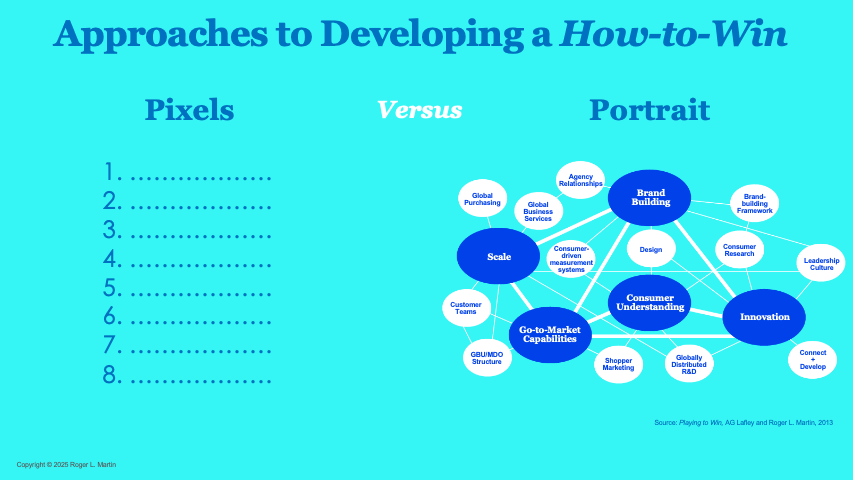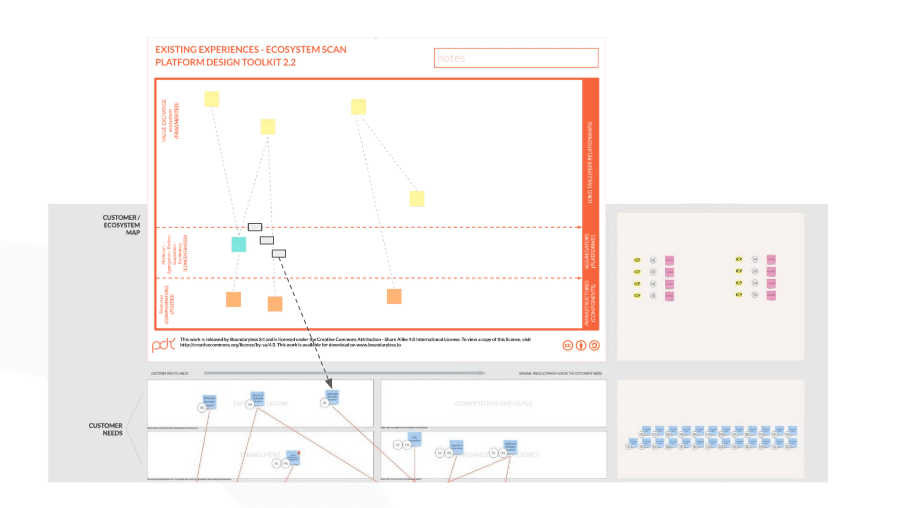From Product to Context: Expanding the Portfolio Map with Ecosystem Scanning
The Portfolio Map Canvas, can be enhanced through the integration of ecosystem scanning approaches. This integration provides organizations with a systematic way to analyze customer contexts, map ecosystem dynamics, and ground their strategic portfolio decisions in platform thinking – ultimately creating a more comprehensive framework for organizational design and strategy execution.
Simone Cicero
As loyal readers will know by now, a couple of weeks ago, we finally released the Portfolio Map Canvas—a new and, in our assessment, pretty revolutionary tool for visualizing an organization as a full stack, starting from customers and their needs down to the single capabilities (teams, units, technologies, data, and more) that make it possible for it to deliver its value propositions.
A Missing Link: From Strategy to Structure
In a recent piece, “Developing a Powerful How-to-Win,” Roger Martin shared a reflection on a too often real truth of organizations. While most spend time defining “where to play,” they rarely articulate a clear and operational “how to win.”
In other words, how exactly will we succeed—given our context, constraints, and capabilities? Roger says:
“The challenge then is to explain the concept of a portrait in the context of strategy. I would argue that it is a diagram that explains and illustrates how individual pieces fit together to produce the desired outcome. It is a portrait that helps to visualize a theory of winning.”

This resonated deeply with us and reminded us how much we believe Boundaryless’ latest release—the Portfolio Map Canvas—is a direct answer to that challenge.
The Portfolio Map provides indeed a strategic visualization engine designed to make the “how to win” not only explicit but visual, interactive, and co-creatable. It links:
- Where To Play (WTP in Roger’s framework) — the customer needs and ecosystem demands,
- How To Win (HTW)— the differentiated offerings and GTM strategies,
- Must Have Capabilities (MHC) — the organizational capabilities, assets, and structures that enable the organization to respond to the needs and perform the strategies.
The idea is simple: structure IS strategy. Conway’s Law told us that in 1968.
“Any organization that designs a system will produce a design whose structure is a copy of the organization’s communication structure.”
The Portfolio Map helps you design that structure to reflect your strategic intent, not just your org chart.
Expanding and Integrating the Portfolio Map Canvas with Customer Ecosystem Mapping approaches
As we highlighted in the release post (The Portfolio Map Canvas: A Revolutionary Tool for Organizational Portfolio Strategy), we’re currently researching how to expand the upper side of the Portfolio Map in search of new insights.
Over the last few weeks, two things have come together in a way that’s pushing our thinking forward.
First, we had a conversation with one of our major customers – a key Fortune 500 player – about how to structure a solid approach to customer ecosystem mapping—one that could be integrated directly into product and capability portfolio thinking.
Second, I’m heading to Paris this week to run a workshop with a high-growth scaleup whose original product is currently experiencing challenges with the team now exploring how to expand into new product bets (embracing a portfolio approach) that needs a clear strategic lens.
In this context, I’ve been prototyping what—looking back—feels almost obvious: using the Boundaryless Ecosystem Scan as a foundational step to map ecosystem dynamics and trace customer needs in the context of systemic interactions.

More than just adding a layer of information, this approach can give the top part of the Portfolio Map—the one that describes customer needs, Go-To-Market strategies, and value propositions—a concrete grounding in platform thinking dynamics as the Ecosystem Scan embeds a lot of such thinking:
- its three layered nature allows for mapping both the interacting players and the mediators, all of which can become “target customers” for our How To Win strategy
- it allows you to map the key resources in the ecosystem
- can be used as a basis to perform value chain analysis that helps define new product/platform ideas
Why the Ecosystem Scan is the Next Logical Step
The Portfolio Map has historically lacked—until now—a strong and systematic way to populate its top section (customer interactions and customer needs) based on a real-world view of the customer context.
This is precisely what we’re now beginning to prototype with clients: using Ecosystem Scans to identify key actors, mediators, and infrastructures. Interestingly new technologies such as GenAI can also be used to complement (ideally not to substitute) deep interviews with AI-supported secondary research to populate the landscape before moving into portfolio design.
There are certainly still directions of development that are very much related to understanding “how to win”, more specifically, we need a solid framework to identify and mapp systems of record, systems of engagement, and systems of intelligence or similar concepts, allowing us to identify what are the “control points” in the ecosystem and how to connect the products we build as an organization in value escalation pathways that increase revenues that can be extracted from the market.
More information on Mapping Ecosystems with the Ecosystem scan is available here: Understanding Ecosystems to create the right Value Propositions: Part 1 of a Series on the Macro-Problems and Techniques of Platform Design – Boundaryless
Toward a Shared Language and Strategic Stack
This work will enable a more repeatable and strategic approach to ecosystem-centric portfolio innovation if we succeed. It will allow teams to:
- Identify new vertical opportunities based on systemic pain points and unmet needs.
- Visualize value escalation paths and bundling strategies.
- Understand capital allocation needs, including where financial engineering can reduce friction in legacy transitions.
- Prototype better GTM strategies aligned with both internal capabilities and external dynamics.
We’re also exploring how this work can feed into more interactive tools and possibly even agentic interfaces that help teams keep portfolio thinking live and aligned across functions.
If you’re interested in being among the few pioneers who are really capable of getting a whole organization to cooperate visually around strategy and build what Roger Martin defines as a portrait of How To Win, reach out on the form below.
The Image below is extracted from our fully released case study of the Portfolio Map Canvas application: the HPro Case Study – explore it here
